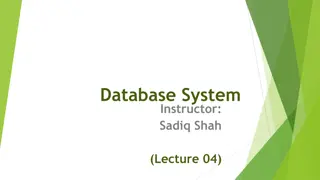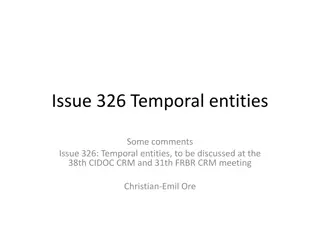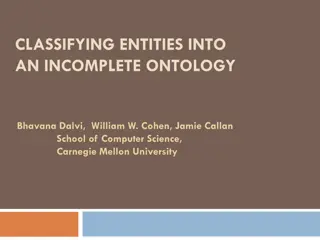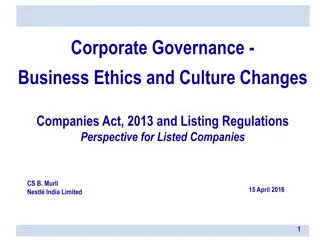Overview of Healthcare and Life Science Market in Saudi Arabia
Saudi Arabia's healthcare and life sciences sectors are a priority, with significant investments and opportunities for firms in medical equipment, pharmaceuticals, and more. The Department for International Trade aims to support UK entities in seizing trade opportunities and fostering a culture of e
1 views • 10 slides
NOT-FOR- PROFIT MAKING CONCERN
Not-for-profit organizations, such as educational institutions, public hospitals, and charitable trusts, operate with the main objective of providing services rather than making profits. These organizations rely on various sources of funding like contributions, donations, and grants. Accounting for
4 views • 4 slides
Comparison of Business Entities and Collaboration Forms
Various forms of business entities such as sole proprietorship, partnership, limited liability company, state-owned enterprises, cooperatives, etc., each come with their own advantages and disadvantages. Additionally, collaboration forms like joint ventures, mergers, acquisitions, etc., allow busine
0 views • 8 slides
Safeguarding Canada's Research: Policy on Sensitive Technology Research and Affiliations of Concern (STRAC)
Canada's new Policy on Sensitive Technology Research and Affiliations of Concern (STRAC) aims to protect the country's research ecosystem from foreign entities posing security risks. The policy restricts funding for projects involving sensitive technology research if affiliated with military or stat
1 views • 10 slides
Promoting Private Sector Engagement in Local Governance through PPPs in Zambia
This presentation outlines the promotion of private sector engagement in local governance in Zambia through Public-Private Partnerships (PPPs). It covers the legal and institutional frameworks, processes, sub-national level PPP projects, current initiatives, lessons learned, and conclusions. The ove
2 views • 23 slides
Understanding the Single Audit Process for Federal Grants
The single audit process is a requirement for non-federal entities receiving over $750,000 in Federal awards, ensuring compliance with program requirements and Uniform Guidance. This audit involves examining financial statements and ensuring proper fund utilization. Auditee responsibilities and key
0 views • 36 slides
State Hospital Reimbursement Programs Overview
State legislatures in 2023 passed SB 228 and HB 2184 directing KDADS to reimburse counties, healthcare providers, law enforcement, and other entities for costs related to holding individuals in custody, observation, and transportation. SB 228 focuses on competency examination and treatment for defen
1 views • 19 slides
Understanding Relationships in Bibliographic Universe
Relationships in bibliographic universe connect entities, providing context through entity-relationship models like IFLA LRM. Learn key terms, principles, and diagrams to identify relationships defined in IFLA LRM. Explore domains, ranges, inverse, recursive, and symmetric relationships. Enhance you
0 views • 23 slides
Understanding 18 U.S.C. 209 and Its Impact on VA Research Personnel
DOJ guidance clarifies 18 U.S.C. 209 for VA employees receiving compensation from non-Federal entities for VA research, highlighting conflicts of interest and legal implications. This law prohibits Federal employees from receiving any form of compensation from non-Federal entities for services rende
0 views • 20 slides
Sanctions Licensing Processes at OFAC Overview
The Office of Foreign Assets Control (OFAC) administers U.S. economic sanctions against targeted foreign entities. This overview covers OFAC's jurisdiction, licensing authorities, application processes, and tips for interacting with OFAC. Compliance with U.S. primary sanctions is crucial, especially
0 views • 32 slides
Vehicle & Asset Management: Surplus Property Distribution to Local Entities
The Surplus Property Program, operated by General Services, manages the redistribution of surplus property purchased with state funding to various entities such as state agencies, local governments, and non-profit organizations. Additionally, the Federal Excess/Surplus Property Program oversees the
0 views • 16 slides
Employee Stock Option Plan Presentation and Guide
This presentation and guide cover the Employee Stock Option Plan, including Black-Scholes Model, practical challenges, market research, and relevant standards like Ind AS 102. It provides an in-depth overview of share-based payments, recognition, measurement, and disclosure requirements, along with
0 views • 71 slides
Understanding Entity-Relationship Diagrams (ERD) for Database Design
Entity-Relationship Diagrams (ERD) are vital in database design, illustrating entities and their relationships. They help in conceptualizing data models and laying the groundwork for database structures. The process involves identifying entities, defining relationships, and analyzing interactions to
0 views • 40 slides
Understanding Modeling Entities and Attributes in Database Systems
Entities, relationships, and attributes are fundamental constructs in the Entity-Relationship (E-R) model. Entities represent people, places, objects, events, or concepts in a user environment. Each entity type has a set of attributes defining its properties. It is crucial to distinguish between ent
2 views • 17 slides
Stunning Apartment Listed at $325,000 - Fully Furnished and Move-In Ready
Explore this exquisite apartment listed at $325,000, featuring modern amenities and stylish decor. With a spacious layout and prime location, this property offers a comfortable and luxurious living experience. Don't miss the opportunity to make this stunning apartment your new home.
0 views • 4 slides
Understanding the Texas Tort Claims Act for State Agencies
The Texas Tort Claims Act (TTCA) outlines the scope of tort liability for State entities and employees during their state employment. State entities are represented by the Office of the Attorney General, and specific provisions apply to state entities separate from municipalities. This overview cove
0 views • 16 slides
Rising Auditor Resignations in Listed Entities: Shocking Trends Revealed
Amidst a surge in auditor resignations at listed firms, a total of 204 companies saw auditors stepping down between January 1, 2018, and July 17, 2018. The trend continued with 32 auditors resigning in the last 5 months, shaping an alarming pattern in the financial sector. Key players like Price Wat
0 views • 33 slides
Modern Apartment for Sale - Listed at $315,000
Stunning apartment listed for sale at $315,000. This modern property offers a contemporary design and luxurious amenities. Check out the images and envision your new lifestyle in this beautiful space.
0 views • 4 slides
Understanding REITs and InvITs in the Securities Market
REITs, or Real Estate Investment Trusts, offer investors the opportunity to own and invest in income-generating real estate assets. They are listed on stock exchanges and must distribute a significant portion of their cash flows to investors. REITs are structured with sponsor and investor ownership,
0 views • 24 slides
Understanding Entity-Relationship Diagrams (ERD)
An Entity-Relationship Diagram (ERD) is a vital data modeling technique for visualizing an information system's entities and their relationships. This graphical representation helps in database design by defining entities, analyzing interactions, and determining cardinality. Entities represent real-
1 views • 40 slides
Audit Quality Maturity Model (AQMM) - Overview and Implementation Guidelines
The Audit Quality Maturity Model (AQMM) is a self-evaluation tool designed for audit firms to assess their level of maturity, identify strengths and weaknesses, and enhance their audit practices. The model covers various operational aspects such as revenue budgeting, technology adoption, and human r
1 views • 14 slides
Discussion on Temporal Entities and Simultaneity in CIDOC CRM Meeting
Temporal entities and the modeling of simultaneity in CIDOC CRM are under discussion at the upcoming meeting. The current approach considers the cardinality of certain relations, aiming to streamline the representation of time-spans and spacetime volumes. The evolving perspectives on the spatial com
3 views • 5 slides
Ensuring Sustainability in Trade of Newly Listed Sharks and Manta Rays
Parties involved in the trade of newly listed sharks and manta rays must adhere to specific guidelines outlined by CITES Scientific Authorities to ensure the survival of the species. This includes obtaining non-detriment findings (NDFs) through scientific assessments, monitoring export permits, sett
2 views • 12 slides
Ministers' Influence on Crown Entities through Strategic Processes
Ministers influence Crown entities by appointing effective boards, engaging in dialogue, participating in strategic planning, and ensuring continuous improvement. They make appointments, hold meetings, receive regular performance reports, and guide entities in setting strategic directions. Through f
0 views • 11 slides
Globalization and the Influence of Nonstate Entities
Globalization is shaped by the power of Multinational Corporations (MNCs), Non-governmental Organizations (NGOs), Inter-governmental Organizations (IGOs), and technological advancements. These entities wield influence on politics, economics, and social dynamics globally. The authority and legitimacy
0 views • 4 slides
Accounting Standards for Non-Corporate Entities Overview
Introduction to accounting standards for non-corporate entities such as partnerships, LLPs, trusts, and nonprofits. Explanation of the applicability of accounting standards based on business size and the classification of Level I, II, III, and IV entities by ICAI. Details of the ICAI announcement da
0 views • 14 slides
Classifying Entities into an Incomplete Ontology: Exploratory EM Approach
The research discusses methods for hierarchical classification of entities into incomplete ontologies. It explores the challenges of evolving web-scale datasets and the need for classifying entities in an incomplete ontology structure. The Hierarchical Exploratory EM model is detailed, providing ins
0 views • 27 slides
Analysis of Kidney Transplant Trends in End-Stage Renal Disease Patients (1996-2013)
This report delves into the trends surrounding kidney transplants in end-stage renal disease (ESRD) patients from 1996 to 2013. It looks at the percentage of dialysis patients wait-listed, unadjusted kidney transplant rates, number of patients wait-listed for kidney transplants, transplant counts, p
0 views • 33 slides
Understanding Listed Companies and Financial Reporting
Listed companies are publicly traded entities whose shares are available on stock markets. They are required to submit annual accounts and reports, including key financial statements like the balance sheet and profit and loss account. The annual report provides insights into the company's financial
0 views • 28 slides
Diverse Social Entities Mining from Linked Data in Social Networks
This research focuses on mining diverse social entities from linked data in social networks using a DF-tree structure and DF-growth mining algorithm. The study explores the extraction of important linked data in social networks and the mining of various social entities such as friends. Prominence va
0 views • 13 slides
Hazardous Waste Pharmaceuticals Proposed Rule Overview
This briefing provides an in-depth look at the Hazardous Waste Pharmaceuticals Proposed Rule from October 20, 2015. It covers which pharmaceuticals are considered hazardous waste, major provisions of the proposal, examples of listed hazardous waste pharmaceuticals, and the flow of hazardous waste ph
0 views • 40 slides
Key Audit Matters (KAM) Guidelines and Requirements Overview
Understand the importance of Key Audit Matters (KAM) in the audit process for listed entities and the public sector in South Africa. Learn about the mandatory and voluntary aspects of KAM reporting, as well as the requirements for identifying, evaluating, and communicating significant audit matters.
0 views • 11 slides
IEEE 802.11-19/0773r0 Multi-link Operation Framework Summary
The document discusses the multi-link operation framework for IEEE 802.11-19/0773r0, focusing on load balancing and aggregation use cases. It introduces terminology related to multi-link logical entities and provides examples of multi-link AP and non-AP logical entities. The framework considers stee
0 views • 16 slides
Corporate Governance and Business Ethics in Listed Companies: Regulations and Perspectives
Corporate governance and business ethics are integral to the success of listed companies, with a focus on internalized values, self-governance, and adherence to moral principles. Key areas include code of conduct, compliance, dealings with related parties, and vigil mechanisms. The Companies Act, 20
0 views • 18 slides
Comparison of Observable Entities in CRM and CRMSci
In this content, different aspects of observable entities in CRM and CRMSci are discussed, including measurements, assignments, simplifications, and adjustments. The evolution and implications of observable entities within these frameworks are explored through various dimensions and properties, shed
0 views • 7 slides
Requirements for Managing Entities in Health Systems
Grant agreements and payments of federal and state financial assistance require compliance with specific statutory authorities. Managing entities must follow guidelines for reporting and reconciling funds, with a focus on transparency and accountability. Providers are required to complete specific s
0 views • 15 slides
Impact of Political Stability on Equity Trading Costs of Cross-Listed Firms
The research explores the relationship between political stability and equity trading costs of cross-listed firms, highlighting the impact of political institutions, liquidity, and investor protection. It delves into the importance of factors like quality of political institutions, transparency, and
0 views • 24 slides
Understanding Entities and Relationships in Database Design
Explore the concepts of entities, entity sets, attributes, key attributes, single-valued and multi-valued attributes, derived attributes, as well as relationships and relationship sets in the context of database design. Gain insights into distinguishing between regular entities, weak entities, and e
0 views • 24 slides
FASAB Update: The Federal Reporting Entity Proposal
Discussions on the Federal Accounting Standards Advisory Board (FASAB) update regarding the reporting model, including proposals for the General Purpose Federal Financial Reports (GPFFR) and the distinction between consolidation entities and disclosure entities. The presentation covers principles of
0 views • 31 slides
Expectations and Responsibilities of Board Members in Statutory Entities
Board members of statutory entities are collectively expected to ensure consistent and effective entity performance, financial responsibility, and collaboration. Individually, they must act with integrity, comply with legislation, and avoid conflicts of interest. Boards have a crucial role in monito
0 views • 5 slides







































